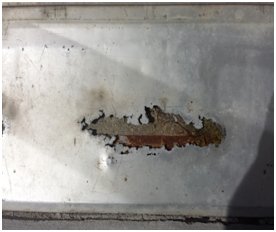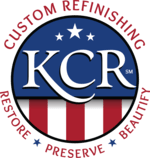With cooler temperatures headed our way this week, KC Restoration thought it would be a good time to begin thinking ahead and preparing for winter precipitation.
Take some time to inspect your property for signs of corrosion and rust. Whenever snow and ice melt is not cleared away from your metal, bronze, stainless steel, aluminum or anodized aluminum siding, the corrosion process begins. Below are some photos of obvious ice melt damage and the corrosion process advancing overtime. If you find any problem areas, address them as soon as possible to avoid more costly repairs due to more advanced corrosion. Then this winter when you experience snow or ice, KC Restoration recommends pressure washing areas of ice melt build-up once warmer temperatures allow. Remember that residual amounts of ice melt left behind after storms will continue the corrosion process and lead to more costly repairs.

Damage from obvious ice melt left behind after a winter storm

Ice melt damage left untreated and the corrosion process advancing overtime
Also check on the type of deicer you use to make sure it won’t speed up the corrosion process. Make sure to beware of chloride, salt which is composed primarily of sodium chloride, and chloride products that claim to be “less corrosive” because they have CMA (calcium magnesium acetate). Chloride ion molecules interact with metal in an electrochemical reaction which accelerates the metal molecules’ interaction with surrounding oxygen creating metal-oxide molecules. This oxidation results in what is commonly called rust. Such metal corrosion can be problematic even when metal cannot be seen directly as steel rebar is used in concrete to reinforce it, especially in parking garages, helicopter pads, and airport runways. The Federal Aviation Administration also prohibits the use of chloride deicers to keep aircraft from exposure to this corrosive material.
To avoid greater corrosion, non-chloride deicers should be used. Common dry non-chloride deicers are CMA (calcium magnesium acetate), sodium acetate and urea. The primary liquid non-chloride deicer for pavement is potassium acetate. Note that none of these chemicals have the word “chloride” in them. KC Restoration advises using potassium acetate liquids which can be found in such products as Ice Guard or Select Liquid Deicer.
Some chloride-based deicers are claiming to be “less corrosive” by mixing in CMA (calcium magnesium acetate). However, these products usually still contain 95-99% chlorides and only about one percent CMA which costs about twenty times as much per pound as salt. This is why only a “pinch” is added to a common deicer. Similar deicing products marketed as corrosion-inhibiting sprays used with a salt also should be treated as suspect. We cannot find any evidence supporting the claim that adding any amount of CMA to salt helps reduce the corrosiveness of chlorides. According to The National Research Council’s Transportation Research Board in their Special Report 235, “there is insufficient evidence to determine whether CMA reduces the rate of corrosion in concrete that is already contaminated with chloride.” As a result, we do not believe that spraying corrosion inhibitors on salt can effectively reduce the corrosiveness of that salt & its chloride. Therefore, it seems that the primary purpose in mixing CMA into chloride-based deicers or spraying “corrosion inhibitors” on chlorides is to help sell the product instead of significantly reduce the corrosiveness of salt.
For your winter preparations, remember to check for chlorides in your deicers, power wash areas of ice melt build-up when warmer temperatures return after winter storms, and repair any areas of corrosion as soon as possible.
If you have any questions about winter’s effects on metal or if you find any areas of corrosion on your property that need repairs, the experts at KC Restoration will be happy to help you.
